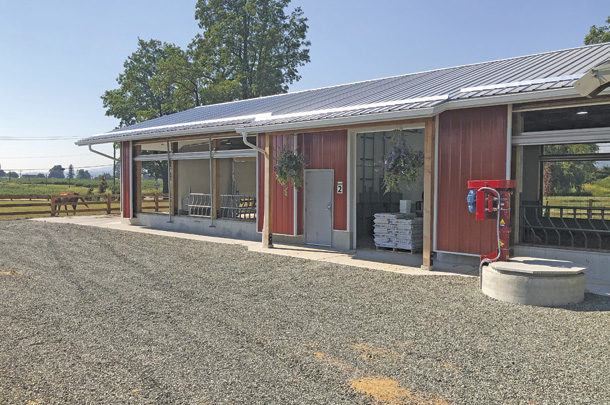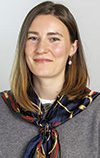With a clear vision in mind, Casey Pruim has focused on effective solutions to improve the functionality and resource use of his dairy, Prime Acres Ltd., located in Abbotsford, British Columbia. Pruim milks 300 cows in a 28-stall rotary parlour. His cows are housed in a freestall barn that features slatted floors and mats topped with recycled bedding, a change from how Pruim used to bed stalls.
About five years ago, Prime Acres added a manure separator to its operation. Pruim says this was done with a few goals in mind.
First, he says, the sawdust he was using on the mats at the time was becoming difficult to find and more costly. To reduce his sawdust costs, Pruim turned to recycled bedding.
However, reducing input costs was not Pruim’s only priority. Pruim owns 150 acres and rents another 50, on which he grows corn and grasses, all used for feed for his cows. Looking to improve his nutrient management, Pruim wanted the capacity to separate manure and avoid spreading sawdust on his fields.
“When we were spreading unseparated manure, we found that the sawdust was actually doing a lot of damage to the grass fields,” he says.
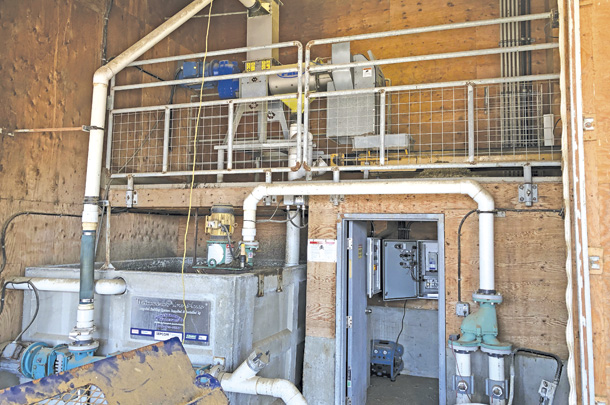 Casey Pruim installed a manure separator to squeeze out the liquid manure and move it into the farm’s manure pit, allowing the manure solids to rest in a short-cycle compost to later be used as recycled bedding. Photo provided by Casey Pruim.
Casey Pruim installed a manure separator to squeeze out the liquid manure and move it into the farm’s manure pit, allowing the manure solids to rest in a short-cycle compost to later be used as recycled bedding. Photo provided by Casey Pruim.
To separate the manure, it is sent through a screw press which squeezes out the liquids and solids. The liquid is sent into the farm’s manure pit, and the solids are pushed out onto a conveyor which sends them into one of two bays. The solids sit in the bays for three days as part of a short-cycle compost. During this process, the solids heat up, killing some of the bacteria they contain. After resting in the bays for three days, the solids are bedded into the stalls. Pruim says that despite a slight rise in udder health issues initially, his herd’s somatic cell count (SCC) has since decreased, and he now sees lower to the same rates of mastitis compared with when he was using sawdust.
Since switching to recycled bedding, Pruim says his farm has reduced its sawdust costs, improved cow comfort and gained more manure storage. Instead of applying nutrients to the field only when it was necessary, he has more choice in acquiring and applying nutrients to his crops, which has improved crop health.
Pruim warns the benefits of the manure separator and recycled bedding may not work for all farms. “We haven’t purchased a cow in probably six years now, and I think that makes a big difference if you’re using recycled bedding … my opinion would be that recycled bedding probably won’t work for a farm that buys a lot of cows or that is going to have to buy a lot more cows,” he says. Pruim says he believes the potential to introduce new bugs or diseases into the herd via new cows would make recycled bedding less effective for farms operating in that manner.
After his farm’s success with its manure separator, Pruim made another big change on his farm: He built a new calf housing facility and transitioned the farm’s calves from calf hutches into the new facility.
The decision to build a calf facility was years in the making. “I’ve always figured that automated feeding was the best way to raise calves – if you could figure out the ventilation – so for years I was a little leery of it until I saw some ventilation systems that work,” Pruim says. The motivation to switch to automated feeding came from Pruim’s desire to grow the calves faster, which would require an increase in labour, something that was not feasible for the farm.
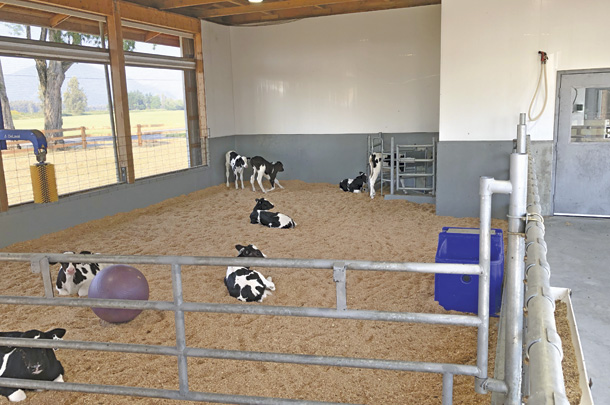 Following the advice of the latest research he has seen, Casey Pruim hopes automated feeding in his new calf housing facility will translate to increased milk production down the line. Photo provided by Casey Pruim
Following the advice of the latest research he has seen, Casey Pruim hopes automated feeding in his new calf housing facility will translate to increased milk production down the line. Photo provided by Casey Pruim
For the calf housing, Pruim settled on a ventilation system composed of automated temperature-controlled curtain sidewalls and a positive-pressure tube. Deciding on this ventilation system was the final push for Pruim to get to work on his dairy’s new calf housing facility. He says the positive-pressure tube works because it exchanges fresh air into the pens, keeping the calves comfortable.
The facility houses the calves in group pens, and Pruim says the automated feeding has been a massive labour-saver. He also notes the labour required to manage the calf housing is easier to perform especially during winter months, as the facility provides employees with protection from the elements.
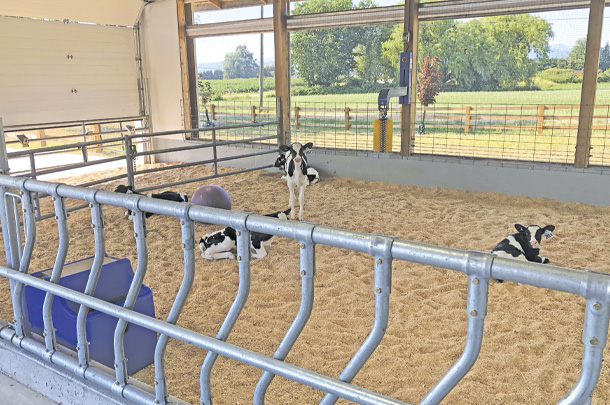 Prime Acres Ltd. was ready to make the switch to a calf housing facility after finding a ventilation system that works for them. The facility features automated temperature-controlled curtain sidewalls and a positive-pressure tube. Photo provided by Casey Pruim.
Prime Acres Ltd. was ready to make the switch to a calf housing facility after finding a ventilation system that works for them. The facility features automated temperature-controlled curtain sidewalls and a positive-pressure tube. Photo provided by Casey Pruim.
Pruim says the research he has read on weight gain in pre-weaned calves helped inform his decision to implement robotic feeding. “The more weight gain you get pre-weaning equals more milk production once the cows are milking, so that was a big incentive for me to try and capture some of that increased milk once [the animals are] in the milking herd,” he says.
Another feature of Prime Acres’ calf housing facility is how it operates under an “all-in-and-all-out” philosophy. After touring calf facilities in Wisconsin and Ontario, Pruim was intrigued by other farms’ experiences with the model of moving calves in and out of the barn all at once and its potential for disease control. “The other big thing was: We wanted to be able to clean it back to new and to do so between each group of calves. Because of the separate rooms, once the calves are out, we can pressure wash [the facility] and disinfect it and bring it back to new for the next group of calves,” he says.
Although he is pleased with the results of his recent endeavours, Pruim says there were some challenges along the way, especially with labour. He says while he did not previously have issues finding labour, the last few years have been difficult. Recently, Pruim has brought in some temporary foreign workers from the Philippines and says they have been “amazing employees,” and the arrangement has solved his labour issues.
Looking towards the future, Pruim says he has been working on improving his herd’s genetic potential. “We’ve focused a lot in the last three to five years on our genetics and on increasing the genetic potential of our herd, working together with our genetic adviser and our vet, and the classification plan, [to] get more kilos of fat off of the same number of cows,” he explains. So far, the farm has seen strong results under the program in a short amount of time.
Reflecting on his operation, Pruim says his advice to producers interested in pursuing a similar style of calf housing is to focus on ventilation. “It doesn’t matter what facility you do, whether it’s individual pens or paired housing or group housing – ventilation is the key. Any system can work when managed properly, but you need to invest in proper ventilation,” Pruim says.
